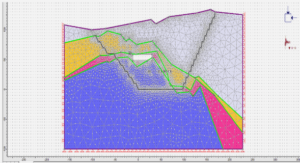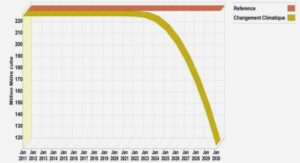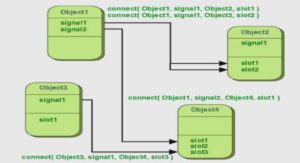The BTES method is normally found in the form of a vertical U-tube heat exchanger buried in the soil. It is composed of a plastic pipe, inserted in a vertically drilled borehole which is can be filled with grout .
To ensure heat transfer to and/or from the ground, a heat transfer fluid is circulated through the plastic tube. Convective heat transfer occurs between the fluid and the inner surface of the plastic tube and conductive heat transfer occurs through the plastic pipe from the inner to the outer surface. There is a contact resistance between the tube and the grout. Then, heat is diffusing across this resistance and the grout. This whole portion of heat transfer is modeled herein as an equivalent borehole thermal resistance that accounts for the four phenomena. However, the contact resistance is found to be negligible and is not considered herein. The outer part, composed of conductive heat transfer from the borehole to the ground and convective heat transfer from groundwater to the borehole, is called ground heat exchanger.
The impact of groundwater flow on geothermal borefields has been studied and models are available (Bauer and al., 2009; Chiasson, 1999; Lee and Lam, 2007; Molina-Giraldo and al., 2011; Niibori and al., 2005; Sutton and al., 2003; Wang and al., 2009). The axial effect and groundwater flow is recommended to be taken into considerations with Peclet numbers between 1.2 and 10 (Molina-Giraldo and al., 2011). Nevertheless, the present research will not take groundwater flow into consideration.
For most of the available studies, the approach to model a BTES system considers heat transferred between:
• the fluid and the inside of the pipe;
• the inside of the pipe and the outside of the borehole;
• the outside of the borehole and the ground;
This framework will be adopted in this study.
These models have been compared with a 2D and 3D finite element analysis with COMSOL® (Lamarche and al., 2010). The 2D models gave better results for the Multipole model, except for the cases where the temperature was constant all around the borehole, such as when steel casing is used.
The 3D approach, based on borehole resistance and internal resistance, showed that the Zeng contribution resembles to COMSOL® results. The COMSOL® analysis was also compared with DST model results. Both methods gave comparable results on long term simulations, but since the capacitance of the borehole is not taken into account in DST, the short term simulations results were incoherent. The 2D models (except Hellström) are analytical, thus does not need to be computed unlike the 3D models numerical analysis.
In most of the models, the fluid is considered to be at uniform temperature (Tb) at the pipe interface, but having different temperatures at the inner and outer part of the U-tube could be more accurate (Lamarche and al., 2010).
Other models are quasi 3D models to take into account the axial heat transfer: Zeng (Zeng and al., 2003), P-linear (Marcotte and Pasquier, 2008) and Spectral (Al Khoury, 2011). Models also take thermal capacities into account to improve short time simulation results. (Bauer and al., 2011; De Carli and al., 2010; Pasquier and Marcotte, 2012; Zarrella and al., 2011), which is an important factor for short-term simulations precision. From this borehole resistance model, the temperature at the outer surface of the borehole (Tb) is calculated and then transferred to the ground models.
Ground models
Ground models can be organized in two categories: analytical and numerical models. Classical analytical models are: Infinite line source model (Ingersoll and Plass, 1948), infinite cylindrical source and finite line source (Claesson and Javed, 2011; Lamarche and Beauchamp, 2007a; Zeng and al., 2002). These models have been reviewed and their validity ranges have been compared (Philippe and al., 2009) as well as their short step-time validity (Lamarche, 2013). Most of the analytical models evaluate the mean borehole surface temperature assuming a uniform heat flow along the borehole, some others evaluate the mean heat flux assuming a uniform borehole temperature (Cimmino and Bernier, 2014). In all cases, the solutions are given for a constant heat pulse, and temporal superposition is used to evaluate the effect of the variation of the heat load into the ground.
Geothermal models have been reviewed by others (Ruan and Horton, 2010; Yang and al., 2010). In these models, the heat transfer is purely conductive, no groundwater convection is considered. The analytical models studied by Philippe et al. (Philippe and al., 2009) are:
• Infinite line source model (Ingersoll and Plass, 1948);
• Infinite cylindrical source (Ingersoll, 1954);
• Finite line source (Eskilson, 1987).
For longer periods (months), the finite line source is more accurate since the effects at the ends of the borehole are taken into account. Most of the analytical models neglect the axial heat transfer, giving more accurate estimations to numerical models. Some numerical and hybrid analytical/numerical models are reviewed by Yang et al. (Yang and al., 2010) are:
• Duct Storage System (DST) (Hellström, 1989);
• Rottmayer (Rottmayer, 1997);
• Li (Li and Zheng, 2009);
• Superposition Borehole method (SBM) (Eskilson and Claesson, 1988);
• Koohi-Fayegh et Rosen’s (Koohi-Fayegh and Rosen, 2014).
The DST simulation model (Hellström, 1989; Pahud and al., 1996), available on TRNSYS (TRNSYS, 2011a) as a component. It is divided in local and global processes and uses cylindrical coordinates and the storage volume is considered cylindrical. Using the finite difference method and an analytical model, the DST model predicts the behavior of a geothermal borefield through time. The method is described in a manual supplied with TRNSYS (Hellström, 1989) and in a thesis (Chapuis, 2008). The DST borefield can only simulate one inlet temperature and flow rate in borefields and the boreholes are considered as uniformly distributed in the borefield.
INTRODUCTION |




